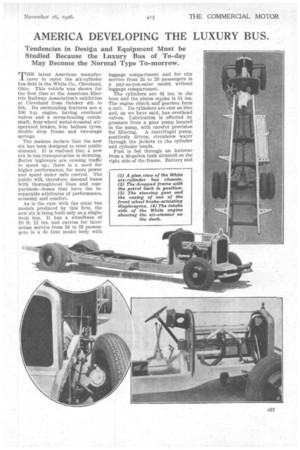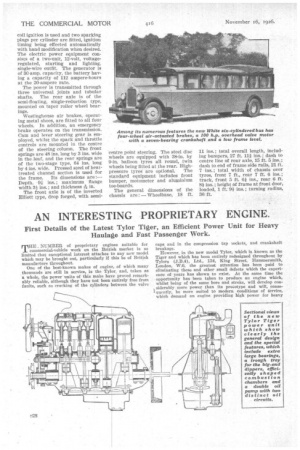AMERICA DEVELOPING THE LUXURY BUS.
Page 49

Page 50

If you've noticed an error in this article please click here to report it so we can fix it.
Tendencies in Design and Equipment Must be Studied Because the Luxury Bus of To-day May Become the Normal Type To-morrow.
rrliE latest American manufac turer to enter the six-cylinder bus field is the White Co., Cleveland, Ohio. This vehicle was shown for the first time at the American Electric Railway Association's exhibition at Cleveland from October 4th to 8th. Its outstanding features are a 100 h.p. engine, having overhead valves and a seven-bearing crankshaft, four-wheel metal-to-metal airoperated brakes, 9-in, balloon tyres, double drop frame and two-stage springs.
The makers declare that the new six has been designed to meet public demand. It is realized that a new era in bus transportation is dawning. Better highways are causing traffic to speed up ; there is a need for higher performance, for more power and speed under safe control. The public will, therefore, demand buses with thoroughbred lines and corapactness—rbuses that have the inseparable attributes of performance, economy and comfort.
As is the case with the other bus models produced by this firm, the new six is being built only as a singledeck bus. It has a wheelbase of 18 ft. 11 ins, and carries for interurban service from 18 to 23 passengers in a de luxe model body with luggage compartment and for city service from 25 to 29 passengers in a pay-as-you-enter model without luggage compartment.
The cylinders are 41 ins, in the bore and the piston stroke is 51 ins. The engine clutch andgearbox form a unit. Its cylinders are cast en bloc and, as we have said, has overhead valves. Lubrication is effected by pressure from a gear pump located in the sump, with careful provision for filtering. A centrifugal pump, positively driven, circulates water through the jackets to the cylinder and cylinder heads.
Fuel is fed through an Autovac from a 46-ga1lon tank situated on the right side of the frame. Battery and coil ignition is used and two sparking plugs per cylinder are fitted, ignition timing being effected automatically with hand modification when desired. The electric power equipment consists of a two-unit, 12-volt, voltageregulated, starting and lighting, single-wire outfit. The generator is of 30-amp. capacity, the battery having a capacity of 112 ampere-hours at the 20-ampere rate.
The power is transmitted through three universal joints and tubular shafts. The rear axle is of the semi-floating, single-reduction type, mounted on taper roller wheel bearings.
Westinghouse air brakes, operating metal shoes, are fitted to all four wheels. In addition, an emergency brake operates on the transmission. Cam and lever steering gear is employed, whilst the spark and throttle controls are mounted in the centre of the steering column. The front springs are 48 ins, long by 3 ins, wide in the leaf, and the rear springs are of the two-stage type, 64 ins, long by 4 ins. wide. Pressed steel of heattreated channel section is used for the frame. Its dimensions are :—
Depth, 9/,. ; maximum flange width 3 ins.; and thickness -log in. The front axle is of the inverted Elliott type, drop forged, with semi
centre point steering. The steel disc wheels are equipped with 38-in. by 9-in, balloon tyres all round, twin wheels being fitted at the rear. High pressure tyres are optional. The standard equipment includes front bumper, motometer and aluminium toe-boards.
The general dimensions of the chassis are : — Wheelbase, 18 ft. 11 ins.; total overall length, including bumpers, 27 ft. 11# ins.; dash to centre line of rear axle, 15 ft. 5 ins.; dash to end of frame side rails, 21 ft. 7 ins. ; total width of chassis over tyres, front 7 ft., rear 7 ft. 6 ins.; track, front 5 ft. 61 ins., rear 6 ft.
ins. ; height of frame at front door, loaded, 1 ft. Of ins.; turning radius, 36 ft.












































































































